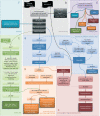PhyleasProg: a user-oriented web server for wide evolutionary analyses
- PMID: 21531699
- PMCID: PMC3125726
- DOI: 10.1093/nar/gkr243
PhyleasProg: a user-oriented web server for wide evolutionary analyses
Abstract
Evolutionary analyses of biological data are becoming a prerequisite in many fields of biology. At a time of high-throughput data analysis, phylogenetics is often a necessary complementary tool for biologists to understand, compare and identify the functions of sequences. But available bioinformatics tools are frequently not easy for non-specialists to use. We developed PhyleasProg (http://phyleasprog.inra.fr), a user-friendly web server as a turnkey tool dedicated to evolutionary analyses. PhyleasProg can help biologists with little experience in evolutionary methodologies by analysing their data in a simple and robust way, using methods corresponding to robust standards. Via a very intuitive web interface, users only need to enter a list of Ensembl protein IDs and a list of species as inputs. After dynamic computations, users have access to phylogenetic trees, positive/purifying selection data (on site and branch-site models), with a display of these results on the protein sequence and on a 3D structure model, and the synteny environment of related genes. This connection between different domains of phylogenetics opens the way to new biological analyses for the discovery of the function and structure of proteins.
Figures
Similar articles
-
PhyloBot: A Web Portal for Automated Phylogenetics, Ancestral Sequence Reconstruction, and Exploration of Mutational Trajectories.PLoS Comput Biol. 2016 Jul 29;12(7):e1004976. doi: 10.1371/journal.pcbi.1004976. eCollection 2016 Jul. PLoS Comput Biol. 2016. PMID: 27472806 Free PMC article.
-
INTREPID: a web server for prediction of functionally important residues by evolutionary analysis.Nucleic Acids Res. 2009 Jul;37(Web Server issue):W390-5. doi: 10.1093/nar/gkp339. Epub 2009 May 13. Nucleic Acids Res. 2009. PMID: 19443452 Free PMC article.
-
MAGOS: multiple alignment and modelling server.Bioinformatics. 2006 Sep 1;22(17):2164-5. doi: 10.1093/bioinformatics/btl349. Epub 2006 Jul 4. Bioinformatics. 2006. PMID: 16820425
-
Phylemon: a suite of web tools for molecular evolution, phylogenetics and phylogenomics.Nucleic Acids Res. 2007 Jul;35(Web Server issue):W38-42. doi: 10.1093/nar/gkm224. Epub 2007 Apr 22. Nucleic Acids Res. 2007. PMID: 17452346 Free PMC article.
-
State-of-the-art bioinformatics protein structure prediction tools (Review).Int J Mol Med. 2011 Sep;28(3):295-310. doi: 10.3892/ijmm.2011.705. Epub 2011 May 23. Int J Mol Med. 2011. PMID: 21617841 Review.
Cited by
-
Genes Encoding Mammalian Oviductal Proteins Involved in Fertilization are Subjected to Gene Death and Positive Selection.J Mol Evol. 2018 Dec;86(9):655-667. doi: 10.1007/s00239-018-9878-0. Epub 2018 Nov 20. J Mol Evol. 2018. PMID: 30456442 Free PMC article.
-
Evolution of genes involved in gamete interaction: evidence for positive selection, duplications and losses in vertebrates.PLoS One. 2012;7(9):e44548. doi: 10.1371/journal.pone.0044548. Epub 2012 Sep 5. PLoS One. 2012. PMID: 22957080 Free PMC article.
-
Positive selection in bone morphogenetic protein 15 targets a natural mutation associated with primary ovarian insufficiency in human.PLoS One. 2013 Oct 16;8(10):e78199. doi: 10.1371/journal.pone.0078199. eCollection 2013. PLoS One. 2013. PMID: 24147118 Free PMC article.
-
Expanding Duplication of Free Fatty Acid Receptor-2 (GPR43) Genes in the Chicken Genome.Genome Biol Evol. 2015 Apr 24;7(5):1332-48. doi: 10.1093/gbe/evv072. Genome Biol Evol. 2015. PMID: 25912043 Free PMC article.
-
PosiGene: automated and easy-to-use pipeline for genome-wide detection of positively selected genes.Nucleic Acids Res. 2017 Jun 20;45(11):e100. doi: 10.1093/nar/gkx179. Nucleic Acids Res. 2017. PMID: 28334822 Free PMC article.
References
-
- Eyre-Walker A. The genomic rate of adaptive evolution. Trends Ecol. Evol. 2006;21:569–575. - PubMed
-
- Graur D, Li WH. Fundamentals of Molecular Evolution. 2nd edn. Sunderland, MA, USA: Sinauer Associates; 2000.
-
- Yang Z. PAML 4: phylogenetic analysis by maximum likelihood. Mol. Biol. Evol. 2007;24:1586–1591. - PubMed



